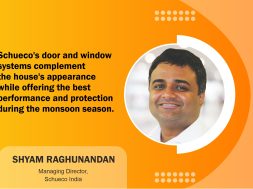Airports and facade cleaning

The use of facades in new age airports is well-known, the magic lies in keeping it and clean glistening in the long run says Ashok Khemlani, Chairman, Cradle Runways (India) Pvt Ltd and a stalwart in the business of facade cleaning, gives an insight on how to go about it.
Once a minister for aviation very aptly said, “That if you construct 3 kms of a road, you can only go up to 3 kms. However, if you construct 3 kms of a runway, you can go anywhere in the world”. How very right. In years to come, the air traffic, the airports will keep growing.
Passenger terminal:
Airport structures are very clearly divided between city side and air side. As the structure itself once again, the inside of it is very clearly divided as a passenger terminal area and piers where there are boarding gates. The passenger terminal area is once again very clearly bifurcated as a check in area, the immigration area, the hand baggage check in area which normally goes out to the retail and then on to boarding piers. The passenger check in area all the way up to retail is a huge area because of its requirement. Normally, this area is with large height which is not the case with baggage check or immigration. And once again, retail and the region of airside has height as a part of other facilities that are built in.
Passenger terminal building is also generally divided at least in four different levels. The departure level, the arrival level and in between that check in baggage, automatic security check and then the ground area which is used for check in baggage loading. The piers also have two levels, one for departure passengers with gates and fixed boarding bridges and aero bridges. Most of the time, it is a fixed boarding bridge which either takes you down to the aircraft door or when you are arriving, then from the aircraft door to further down to arrival level.
Depending on passenger handling capacity of the airports, the total passenger handling area, check in islands, retail area and number of boarding gates are designed.
Air conditioning and lighting:
One of the key requirements of the airports is air conditioning and lighting. The air conditioning in large airport terminals is absolutely necessary. This is because of the large number of passengers and the airport staff besides the service providers that move around both at departure and of course much lesser but also in the arrival area. Very clearly even the piers have to be air conditioned because the passengers generally have to wait before boarding the aircrafts. On the city side, there is a requirement of multiple traffic lanes for the cars and other vehicles which brings in the passengers to the forecourt area. Even this cannot be open to the sky because of monsoon, summer time, etc. There are always canopies and multiple gates for taking the passengers to the departure area along with their checked in and hand baggage and series of check in islands.
The lighting requirement is very high because of working hours at airports. Most of the large international airports work for 24 hours a day and the domestic airports for about 20 – 21 hours a day. To provide better lighting, it is always desirable to maximize availability of natural light. It is also true that the passengers specially other than frequent travelers like the view of the aircraft movements. Once upon a time, there used to be viewing galleries and people used to buy tickets to see the airside. These departure areas and retail and pier areas are always with a glass frontage to improve lighting. They also have large skylights to provide the natural light which is required in abundance.
Facades in Airports:
Airports are also known for heavy footfall and sometimes very large crowds especially when the flights are delayed or bunching of flights. Very obviously, the façade, both from inside and outside that of the passenger terminal building and pier needs to be cleaned.
First the city side. The look of the city side and the clean face of the airport has a brand equity of the passenger building. With multiple ornamental gates, large number of displays and invariably tall glass facades and the canopies at top welcome the passengers. These areas because of the heavy passenger traffic movement and interjection of gates are easier to clean using aerial work platforms or other mechanized means. Many times, they also have high column areas for the passenger movement and once again interjected by elevators to go down to arrival, etc. There is a use of multiple varieties of façade access equipment such as aerial work platforms, scissor lifts, vertical platforms. Even the canopies have to be cleaned both from under and above the canopy since they are Tencent fabric or they are open to the sky. Some of the areas in the forecourt of the city side are best handled by ultra clean water purification systems and carbon lightweight telescopic poles to reach and clean. As we go in, in the departure area, the check in islands are to be cleaned in the shortest possible time and they are best handled by snap fit scaffolding towers or low height aerial platforms. It is very important to keep the ground occupation as low as possible because there are always queue managers, display boards, check in counters, etc.
In the departure area, it is also necessary to have either built in walkways or large aerial work platforms reaching 35-40 meter height for cleaning skylights, display boards and other structures which will depend on the architecture of the departure area.
As compared to the city side, the air side is completely different. There is no passenger movement unless the aircraft is parked next to the terminal and passengers are made to walk to the aircraft. But this is not so in the large terminal buildings with multiple boarding bridges. The air side generally has huge length. The glass façade is best handled by an aluminum alloy track and power operated cradle. The power operation has to be both for vertical movement and for the horizontal movement. Even inside the passenger terminal building, the piers and the fixed boarding bridges need to be cleaned very regularly because of high passenger movement inside. The air side could be easy to clean by vertical gantry but for the interjection of boarding bridges because of which aluminum alloy track and the cradle is more suitable.
On the air side, there are also nodes which bring the passengers from the terminal by various fixed boarding bridges and let them move in the node from fixed boarding bridges to the aero bridges moving to the aircraft. Invariably, both fixed boarding bridges and aero bridges are with a glass façade. They also need to be cleaned both from outside and inside. The nodes and the fixed boarding bridges besides the aero bridges require aerial work platforms.
Use of Aerial Work Platform at airports:
The equipment that is required which includes aerial work platforms, aluminium alloy track, travelling ladders, ultra clean water purification systems, long carbon poles, rolling towers are all of a special nature. For eg. aerial work platforms need to have less reaction on the departure slab.
Even the positioning of aerial work platforms is very important because of check in islands, passenger seating areas and the skylights. After positioning the aerial work platform, it should be able to reach the skylight even though there are hindrances which are there at the departure level inclusive of the check in islands, the air conditioning towers, columns, passenger seating area, etc. Even the ultra clean water purification system needs to be specifically designed depending on the total area to be cleaned and the height at which the cleaning is required. On the air side, generally there is no problem attached on the ground since it has the high reaction capacity.
However, the articulation and the telescopic part of these platforms have to be carefully worked out because of the very nature of the heavy bus movement, cargo trolley movement and several other vehicles. Besides, the nodes and fixed boarding bridges are maximum utilized by all terminal buildings. The time available for cleaning of the façade is very limited. Many places, it is also necessary to provide ultra clean water purification systems with light weight carbon water fed poles to clean the nodes and the nodes under fixed boarding bridges. These do require extensive cleaning because there is carbon deposit which comes in because of the aircraft tyres breaking and fairly heavy traffic movement of vehicles. Sometimes, for the main façade on the air side, there is use of even truck mounted aerial platforms or travelling gantries. Depending on the capacity, a large terminal building may have several equipment which are airport design specific.
ATC towers:
The ATC towers provide a completely different challenge for the façade access systems. To begin with, one has to always consider the specific design of sloping glass façade of 20 mtr height located at the tallest point which can even be 100 meters above the ground level. This is to provide clear vision to air traffic controllers. There is also a wind factor. The wind velocity at the height of 100 meters and above is surely a huge consideration besides the specific design of the air traffic controller seating area and the central column which houses the elevators, the emergency staircases and the external finish needs to be considered for cleaning. One has to also consider the equipment like radars, etc installed above the air traffic controller tower. Two different types of equipment have been used for façade cleaning of the ATC towers. Besides, sometimes, there is a platform provided for the operative to work and clean the external façade.
There are towers where BMUs are provided at top and then there are those where travelling gantry has been provided which goes around the ATC tower. Of course, even the travelling gantry, there has to be a landing platform and approach for the operatives to reach. These gantries are also special. They provide protection from both sides and the steps which are horizontal and designed in such a way that the operative is able to walk up and down conveniently without any hazard. There is always a provision of ladder lock so that the cleaning operative is able to attach his harness and at the same time he is safe in case he falls. It is even possible to mechanize them by electrical movement or a manual wheel for ease of movement. At some airports, gantries are provided in such a way that an engineer can walk up and reach the ATC roof.
The airports do not have parapet walls. They always have sloping roofs since the height requirement differs. There is also an ATC tower with huge height. All airport terminals do require a fall arrest system. This is so that the operatives who are cleaning the roof or the skylight above or on top of the fixed boarding bridges or above the ATC towers, do not slip down. The fall arrest has to be carefully designed. In case of the fall arrest on aero bridges, there is a narrow pathway which the operator can use to clean the top of it.
To save power bills, there is always a bull nose above the passenger terminal building. This is to avoid the sun directly hitting the front glass. To clean the bull nose which is always a signature façade, a specially designed gantry is provided at almost all the airports. It is for these areas, that even aerial work platforms are not really workable.
79
Cookie Consent
We use cookies to personalize your experience. By continuing to visit this website you agree to our Terms & Conditions, Privacy Policy and Cookie Policy.









